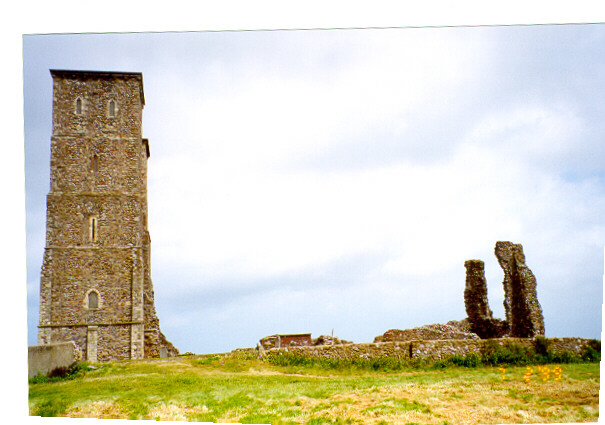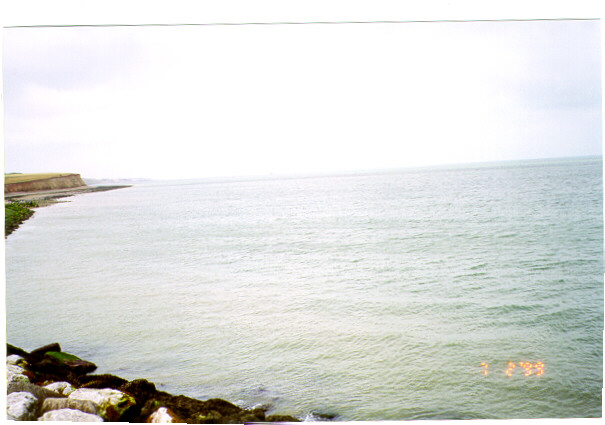
|
 |
Alexander "Sasha" Volokh
My tour of medieval Europe
Reculver/Hearne Bay, England, July 1, 1999

Above: Bassa's Monastery -- all that remains after the depredations of the vandal-vicar
"For the year 669, the Anglo-Saxon Chronicle has the following laconic entry: 'In this year King
Egbert gave Reculver to Bassa the priest to build a church there.'
This grant marks the starting point of the Anglo-Saxon history of Reculver, but the site has a long
history of occupation before this.
Bassa, like St Cedd at Bradwell-on-Sea in Essex, had been granted not an empty site but a ruined
Roman Saxon short fort.
These forts, which formed a chain stretching along the south and east coasts of England, were
commanded during the 4th century by the Comes Litoris Saxonici -- the Count of the Saxon
Shore.
They were used as bases for the Roman fleet which was charged with the defence of the coast against
the piratical attacks of the early Anglo-Saxons, hence the Count's title.
"Bassa and Cedd were probably given the old forts because their defences, although ruined, still
acted as a barrier between the outside world and the land within.
Both men led small communities of monks, and the forts made ideal sanctuaries in which they could
carry on their religiosu life.
This idea of a 'closed community' physically separated from the world of men was an essential element
of many early monastic traditions; the defences of the shore forts provided ready-made precinct
walls.
"A further advantage of the shore forts was that their ruined buildings afforded a handy source of
building materials.
We know from the remains of Bassa's church that he plundered the ruins of Regulbium -- as the fort
had been called by the Romans -- for bricks and tiles as well as for stone.
The plan of his church, which is marked out on the site, was excavated in 1927.
It resembled that of St. Augustine's abbey at Canterbury, having a broad nave with flanking porticus
and a rounded apse.
This basic plan was extended during the 8th century by the addition of a western porch or 'narthex.'"
Nigel & Mary Kerr, A Guide to Anglo-Saxon Sites (1982), pp. 192-94 (subsequent quotes are from
the same source)

Above: View of Hearne Bay.
Imagine Saxon invaders appearing on the horizon!
"Between the nave and chancel was an elegant arcade of three arches made from Roman bricks and
supported on two tall stone columns.
A low seat running round the inside of the apse was for the use of the abbot and his monoks.
The abbot sat in the centre, directly behind the altar, with his monks ranged around the sides.
The doorways into the porticus from the chancel are thought to have been lined with stone.
Slots for this purpose may be seen in the stone threshold of the north door close to the jambs.
The linings may have resembled the somewhat later work at Britford in Wiltshire.
In the north porticus the sills of the original windows may be seen, whilst in the north wall of the
later western narthex the seating for a wooden window frame is preserved under glass.
"The little church at Reculver, with its commanding seaside site, must have attracted the attention
of Viking pirate bands at an early date.
We do not know when the church was sacked, nor for how long its congregation braved the menace before
withdrawing inland, but monastic life had ceased here by the early 10th century.
Later it served as a parish church, and was considerably extended during the Middle Ages.
The church resisted wind and tide until 1805 when the young clergyman of the parish, urged on by his
Philistine mother, rashly besought his parishioners to demolish this shrine of early Christendom.
This they duly did and all save the western towers, which still act as a landmark for shipping, was
razed to the ground.
The sad history of Reculver was not yet done.
Shortly before World War II a caravan site was established below the church which has since grown so
large that much imagination is now required to conjure up the majesty of its former setting."
Back to Canterbury
Advance to Hastings/Battle
Return to places page
Return to home page
|